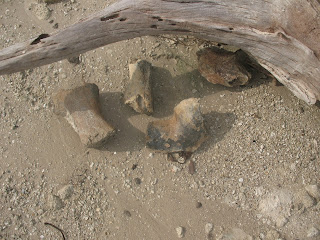A deep seated roar seemed to surround us. It not only came from the air but it also seemed as if the water itself were vibrating. The others on the observation deck looked around and the only one unconcerned was the American Bittern that was concentrating on its fishing and possible morning breakfast.
We had decided to take a break from our busy schedule,(go ahead and laugh if you wish), and go birding at the Aransas National Wildlife refuge. It was kind of like our personal bird count for the end of 2010 and we hoped to at least see a few whoopers.
Leaving Wateredge it was a short drive to the refuge and Renita started to record our daily bird list. Quickly she started it with a northern harrier and then added a cara cara as we passed seven scattered next to the road way. A red tailed hawk perched on a pole and of course we saw northern mockingbirds and the usual little grey birds, although I was sure one was a black crested titmouse.
Arriving we registered at the refuge headquarters where the volunteers seemed a little unsure of themselves but they probably had just arrived and we got the expected whooper totals after a little prodding. Our first stop was at Jones Lake and the parking lot was full of cars as lots of birders where taking advantage of the holiday season.
As we walked out on the deck one side was full of cameras with large lenses and one of the photographers motioned to us to come near and see the American bittern. It was totally unconcerned with all the attention as it concentrated on its fishing and we got a great and close view of what for us was a new life list bird!.
A huge gator was across the lake and it shook the air with its mating call. It was the first time we have ever heard an alligator roaring and it really did seem to shake the air and water, much like one of those horns that shook everybody at the World Cup. Another gator answered in challenge but it was across the lake.
Renita pointed out the huge gator as it continued to roar and stretched out its head, pointing it into the air as it arched its body and emptied its lungs. Such a primal sound that has been heard for millions of years and we felt lucky to actually hear it.
We left the throng and mosquitoes at Jones Lake and headed to the Rail Trail and Observation Tower. As we climbed the Tower ramp we were greeted with a strong south wind that shook our spotting scope so much that it was almost useless. Across the flats a pair of whoopers were feeding and I thought I spotted another pair much further down the way, on some spoil piled along the Intercoastal waterway.
Next was the rail trail where hundreds of pintails started to fly away in wave after wave! A greater yellowlegs stood perched and sleeping on one leg while several lesser yellowlegs searched for food,(They have a updated bird list at the visitor center and it sure helps me zone in on the kind of birds to expect at each spot).
It was lunch time and we ate as we drove along the eleven mile road where more lgbs,(little grey birds), and a kestrel highlighted the drive. Our next stop was at Big Tree where we climbed down the eroded bank and then walked along the beach.
Turning around I noticed a rock underneath a stump and as I neared it took form, a large pleisticene fossil bone! Excited I noticed more bones underneath the stump and I turned over the stump to uncover someones cache of possible mammoth bones.
Hoping it was a park rangers find and not the pile of a fossil poacher I recovered the bones with the stump and headed back to tell Renita. I saw several smaller bones exposed along the beach front and even found a part of a fossil tooth, perhaps a piece of mammoth tooth , and took a photo of it before returning it to the spot it had laid in.
A sign nearby warned that the site was a place of archaeological significance and I was a little confused as to whether it was due to the mammoth bones or if it was the old site of early human habitation. We stopped at the headquarters to report the fossil bones and sure enough there was a display of mammoth bones and tusk pieces on the wall.
Of course we also stopped at Heron Flats where we saw a small flock of spoonbills and another and larger one of snow geese. We walked down the trail a little bit and there were the alligators and they looked like the same ones from last year. Another couple came by and the man suggested to his wife that she should go over by the gators for a picture but she ignored him and didn't respond.
Our final stop was at the small pond near the visitor center. A green kingfisher had been reported there that morning but we didn't see much as the rushes have overgrown the pond. Renita drove back to Rockport and we talked of the day, the beauty of the American Bittern and the bonus of the alligator's roars. A good day afield and an inspiration for more birding! Clear skies





No comments:
Post a Comment